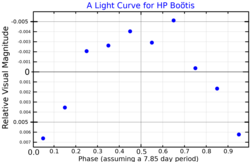HD 130948 or HP Boötis is a variable star with 2 brown dwarfs in the constellation Boötes. With an apparent magnitude of 6.0, it is faintly visible to the naked eye under very good observing conditions. It has a stellar classification of G1V, which means it is a main sequence star with a mass and surface temperature that are similar to the Sun. The estimated age of this star is also similar to the Sun at 4.7 billion years (Gyr) old, but it has a lower proportion of elements (63%) other than hydrogen or helium. However, a separate study in 2009 gave a much younger age of 0.5 ± 0.3 Gyr and a higher metallicity that is very similar to the Sun.[7]
| Observation data Epoch J2000 Equinox J2000 | |
|---|---|
| Constellation | Boötes |
| Right ascension | 14h 50m 15.8112s[2] |
| Declination | +23° 54′ 42.639″[2] |
| Apparent magnitude (V) | 5.9949[3] |
| Characteristics | |
| Spectral type | G1V[4] |
| U−B color index | +0.01[5] |
| B−V color index | 0.576[3] |
| Variable type | BY Dra |
| Astrometry | |
| Radial velocity (Rv) | −1.5[6] km/s |
| Proper motion (μ) | RA: 143.91[3] mas/yr Dec.: 32.69[3] mas/yr |
| Parallax (π) | 55.03 ± 0.34 mas[3] |
| Distance | 59.3 ± 0.4 ly (18.2 ± 0.1 pc) |
| Details | |
| Mass | 0.97[4] M☉ |
| Surface gravity (log g) | 4.18[4] cgs |
| Temperature | 5,780[4] K |
| Metallicity | [Fe/H] = -0.20[4] or 0.00[7] |
| Age | 4.7[8] or 0.5[7] Gyr |
| Other designations | |
| Database references | |
| SIMBAD | data |
Eric J. Gaidos et al. observed the star in 1998 and 1999, and discovered that it is a variable star.[9] It was given its variable star designation, HP Boötis, in 2006.[10]
In 2002, a pair of co-orbiting brown dwarfs were discovered in orbit around this star. They were found using an adaptive optics instrument on the Gemini North 8m telescope in Hawaii.[11] The pair have a 10-year orbital period about the primary star, and their combined mass is 10.9% of the Sun's mass.[7]
The space velocity components of this star through the Milky Way galaxy are (U, V, W) = (−14.0, 14.7, −0.1).[4]
References
edit- ^ Gaidos, E. J.; Henry, G. W.; Henry, S. M. (August 2000). "Spectroscopy and Photometry of Nearby Young Solar Analogs". The Astronomical Journal. 120 (2): 1006–1013. Bibcode:2000AJ....120.1006G. doi:10.1086/301488. S2CID 16930014.
- ^ a b Perryman, M. A. C.; et al. (April 1997). "The HIPPARCOS Catalogue". Astronomy & Astrophysics. 323: L49 – L52. Bibcode:1997A&A...323L..49P.
- ^ a b c d e van Leeuwen, F. (November 2007). "Validation of the new Hipparcos reduction". Astronomy and Astrophysics. 474 (2): 653–664. arXiv:0708.1752. Bibcode:2007A&A...474..653V. doi:10.1051/0004-6361:20078357. S2CID 18759600.
- ^ a b c d e f Chen, Y. Q.; Nissen, P. E.; Zhao, G.; Zhang, H. W.; Benoni, T. (February 2000). "Chemical composition of 90 F and G disk dwarfs". Astronomy and Astrophysics Supplement. 141 (3): 491–506. arXiv:astro-ph/9912342. Bibcode:2000A&AS..141..491C. doi:10.1051/aas:2000124. S2CID 16273589.
- ^ a b "V* HP Boo -- Variable of BY Dra type". SIMBAD. Centre de Données astronomiques de Strasbourg. Retrieved 2010-10-03.
- ^ Evans, D. S. (June 20–24, 1966). "The Revision of the General Catalogue of Radial Velocities". In Batten, Alan Henry; Heard, John Frederick (eds.). Determination of Radial Velocities and their Applications, Proceedings from IAU Symposium no. 30. University of Toronto: International Astronomical Union. Bibcode:1967IAUS...30...57E.
- ^ a b c d Dupuy, Trent J.; Liu, Michael C.; Ireland, Michael J. (February 2009). "Dynamical Mass of the Substellar Benchmark Binary HD 130948BC". The Astrophysical Journal. 692 (1): 729–752. arXiv:0807.2450. Bibcode:2009ApJ...692..729D. doi:10.1088/0004-637X/692/1/729. S2CID 119237470.
- ^ Holmberg, J.; Nordstrom, B.; Andersen, J. (July 2009). "The Geneva-Copenhagen survey of the solar neighbourhood. III. Improved distances, ages, and kinematics". Astronomy and Astrophysics. 501 (3): 941–947. arXiv:0811.3982. Bibcode:2009A&A...501..941H. doi:10.1051/0004-6361/200811191. S2CID 118577511.
- ^ Gaidos, E. J.; Henry, G. W.; Henry, S. M. (August 2000). "Spectroscopy and Photometry of Nearby Young Solar Analogs". The Astronomical Journal. 120 (2): 1006–1013. Bibcode:2000AJ....120.1006G. doi:10.1086/301488. Retrieved 6 December 2024.
- ^ Kazarovets, E. V.; Samus, N. N.; Durlevich, O. V.; Kireeva, N. N.; Pastukhova, E. N. (August 2006). "The 78th Name-List of Variable Stars" (PDF). Information Bulletin on Variable Stars. 5721: 1–45. Bibcode:2006IBVS.5721....1K. Retrieved 6 December 2024.
- ^ Potter, Daniel; Martín, Eduardo L.; Cushing, Michael C.; Baudoz, Pierre; Brandner, Wolfgang; Guyon, Olivier; Neuhäuser, Ralph (March 2002). "Hokupa'a-Gemini Discovery of Two Ultracool Companions to the Young Star HD 130948". The Astrophysical Journal. 567 (2): L133 – L136. arXiv:astro-ph/0201431. Bibcode:2002ApJ...567L.133P. doi:10.1086/339999. S2CID 16249194.
